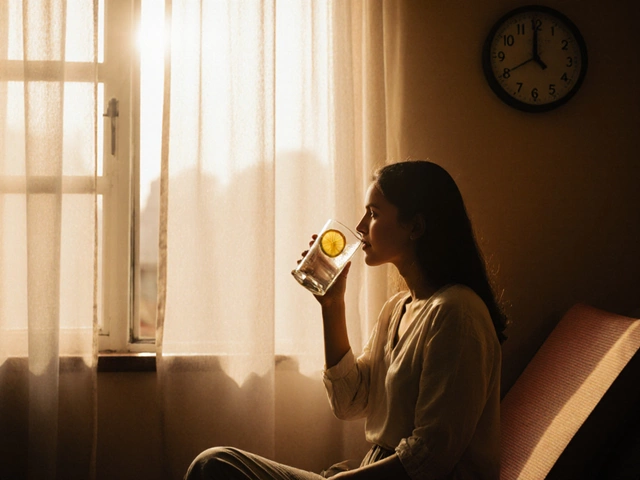Most people think Ayurveda is about complicated herbs, long rituals, and strict diets. But the truth? Its most powerful tool is simple: the 80/20 rule. It’s not about perfection. It’s about balance. In Ayurveda, the 80/20 rule means you follow your ideal routine 80% of the time and allow flexibility for the other 20%. This isn’t just a tip-it’s how millions in India have stayed healthy for thousands of years without burning out.
Why the 80/20 Rule Works in Ayurveda
Ayurveda doesn’t believe in rigid rules. It believes in rhythm. Your body, mind, and environment are always changing. One day you’re tired, the next you’re energetic. One season you crave warm food, another you want cool drinks. Trying to stick to a perfect routine every single day? That’s stress. And stress? It’s the biggest cause of imbalance in Ayurveda.
The 80/20 rule says: Do what works for your dosha 80% of the time. That’s enough. The other 20%? That’s your breathing room. It’s the cup of coffee on a cold morning. The late-night snack after a long day. The skipped morning yoga session because your toddler wouldn’t stop crying. These aren’t failures. They’re human.
Think of it like this: If you eat heavy, fried food three times a week and balance it with light, warm meals four times, your digestion stays strong. But if you try to eat only boiled vegetables and lentils every single day, you’ll end up resenting it-and your body will feel the strain. Ayurveda is about harmony, not punishment.
How the 80/20 Rule Applies to Your Dosha
Your dosha-Vata, Pitta, or Kapha-is your unique mind-body type. The 80/20 rule works differently for each.
- Vata types (thin, energetic, prone to anxiety) need routine most. But pushing too hard? They get overwhelmed. Stick to regular meals and sleep 80% of the time. The 20%? Allow spontaneous walks, unplanned tea breaks, or skipping meditation when you’re exhausted. It keeps Vata grounded, not rigid.
- Pitta types (sharp, driven, intense) love control. They want to optimize everything. But that’s their downfall. For Pitta, the 80/20 rule means eating cooling foods most days (like cucumber, coconut, mint) but letting yourself enjoy spicy food or a glass of wine once in a while. Without that 20%, Pitta gets resentful-and then irritable, angry, or burnt out.
- Kapha types (steady, slow, grounded) need movement and lightness. But forcing intense workouts daily? They quit. The 80/20 rule here means moving your body 4-5 days a week (walking, yoga, dancing) and allowing rest or slow days the rest. Eat warm, spiced food most days, but let yourself have a sweet treat or creamy dish once a week. That keeps Kapha motivated, not stuck.
The key? Know your dosha. If you don’t, start by noticing: Do you feel anxious and scattered (Vata)? Hot-tempered and overworked (Pitta)? Sluggish and heavy (Kapha)? That’s your starting point.
Daily Routine (Dinacharya) Made Real
Ayurveda’s ideal daily routine includes waking early, oil pulling, tongue scraping, meditation, warm water, light exercise, and eating meals at fixed times. But here’s the truth: Only 5% of people do this perfectly. The rest? They do 80% of it.
Here’s how to make it work:
- Wake up within 1 hour of sunrise (80% of days). On weekends or travel days? 2 hours is fine.
- Drink a glass of warm water with lemon every morning (80%). If you forget? Just drink water later. No guilt.
- Practice 10 minutes of breathing or quiet sitting (80%). On busy days? 3 minutes counts. Breathe slowly. That’s enough.
- Eat your largest meal at noon (80%). Dinner? Keep it light. But if you’re at a friend’s house and they serve a heavy curry? Enjoy it. Your body can handle it once in a while.
- Go to bed by 10:30 PM (80%). If you’re watching a movie or need to finish work? Stay up until 11:30. Don’t stress. Just get back on track the next night.
That’s it. No need for apps, trackers, or perfection. Just consistency with kindness.

Food and the 80/20 Rule
Ayurveda doesn’t ban foods. It matches food to your body’s needs. The 80/20 rule here is simple: Eat foods that balance your dosha 80% of the time.
For example:
- If you’re Vata, eat warm, cooked, oily foods-soups, stews, ghee, bananas. Avoid raw salads and cold drinks most days. But one crisp apple or iced tea? Fine. Just don’t make it a habit.
- If you’re Pitta, choose sweet, bitter, and astringent foods-rice, leafy greens, milk, coconut. Avoid spicy, sour, or fried foods daily. But one plate of spicy biryani during Diwali? Go ahead. Your body won’t collapse.
- If you’re Kapha, eat light, dry, warm foods-millet, lentils, ginger tea, steamed veggies. Avoid heavy dairy, sweets, and fried food. But one piece of jalebi during a festival? Enjoy it. Then get back to your routine.
The goal isn’t to eat ‘Ayurvedic’ food. It’s to eat food that keeps you feeling light, clear-headed, and energized. If you feel bloated, tired, or foggy after eating something, it’s a sign. Adjust. But don’t punish yourself.
Seasonal Adjustments and the 80/20 Rule
Ayurveda teaches that each season affects your dosha differently. Monsoon increases Kapha. Summer increases Pitta. Winter increases Vata. Your diet and routine should shift slightly with the seasons.
But here’s the catch: You don’t need to overhaul your life every time the weather changes. That’s where 80/20 shines.
For example:
- In summer (Pitta season), drink more coconut water, eat less spicy food, avoid midday sun. But if you’re at a barbecue and eat a burger? Don’t panic. Just drink cooling mint tea after.
- In winter (Vata season), add ghee to your meals, wear warm clothes, go to bed earlier. But if you’re stuck in traffic and your tea goes cold? Drink it anyway. Your body doesn’t need perfect conditions.
Small shifts, not big changes. That’s the Ayurvedic way.
What Happens When You Break the 80/20 Rule?
People often think: ‘If I skip my routine for a week, I’ve ruined everything.’ That’s the myth.
Here’s what really happens:
- Miss a week of oil pulling? No big deal. Your mouth won’t fall off.
- Eat junk food for three days straight? You might feel sluggish. But one day of light meals and warm water brings you back.
- Stay up late for three nights? You’ll feel tired. But if you sleep by 10 PM for the next two nights, your energy returns.
Ayurveda doesn’t punish. It guides. Your body is smart. It knows when it’s out of balance. And it recovers quickly-if you don’t make it a crisis.
The real problem isn’t occasional indulgence. It’s guilt. It’s shame. It’s thinking you’ve failed because you didn’t follow a rule perfectly. That’s what breaks your health-not the occasional pizza.

Real-Life Examples from Bangalore
I’ve seen this work in real life. A teacher in Whitefield, Vata-dominant, used to force herself into 6 AM yoga every day. She got anxious, lost sleep, and started skipping meals. Then she tried 80/20: yoga 4-5 days a week, rest the rest. Within weeks, her anxiety dropped. Her digestion improved. She slept better.
A software engineer in Koramangala, Pitta-dominant, ate only salads and green smoothies. He was always angry, had acid reflux, and couldn’t relax. He started eating one warm, spiced meal a day-like khichdi or dal rice. He allowed himself one glass of wine on weekends. His mood stabilized. His skin cleared up.
A homemaker in Indiranagar, Kapha-dominant, felt stuck. She ate heavy meals every night. She rarely moved. She tried a 10-minute walk every day, even if it was just around her apartment. She ate one sweet treat a week. Within a month, she had more energy. Her joints didn’t ache as much.
They didn’t become perfect. They became consistent. And that made all the difference.
How to Start Today
You don’t need to change everything. Start with one thing.
- Choose your dominant dosha (ask yourself: Am I usually anxious? Hot-headed? Heavy? Slow?)
- Pick one daily habit from the routine: warm water in the morning, or 5 minutes of breathing, or eating dinner before 8 PM.
- Commit to doing it 80% of the time this week.
- Let go of the other 20%.
That’s it. No apps. No tracking. Just awareness and kindness.
Ayurveda isn’t about being perfect. It’s about being present. It’s about listening to your body-not your guilt. The 80/20 rule isn’t a hack. It’s the oldest, wisest form of self-care we have.
Frequently Asked Questions
Is the 80/20 rule in Ayurveda the same as the Pareto Principle?
They share the same number, but they’re not the same. The Pareto Principle (80/20 rule) in business says 80% of results come from 20% of efforts. In Ayurveda, the 80/20 rule is about balance and sustainability. It’s not about maximizing output-it’s about preserving energy, reducing stress, and staying aligned with your body’s natural rhythm. It’s self-care, not productivity.
Can I use the 80/20 rule if I have a chronic condition?
Yes-but with awareness. If you have diabetes, high blood pressure, or digestive issues, the 80/20 rule still applies, but your 80% needs to be more focused. For example, if you’re diabetic, your 80% might mean eating low-glycemic foods, while your 20% could be a small piece of fruit or a rare dessert. Always work with an Ayurvedic practitioner if you have a medical condition. The rule helps you stay consistent without burnout, but it doesn’t replace medical care.
What if I don’t know my dosha?
Start by observing yourself. Do you feel anxious, restless, or cold often? You’re likely Vata. Do you get angry easily, burn out fast, or crave cool things? You’re likely Pitta. Do you feel heavy, slow, or sleepy after eating? You’re likely Kapha. You can also take a free online dosha quiz from trusted Ayurvedic sites. But the best way? Notice how you feel after eating, sleeping, or being active. Your body tells you.
Does the 80/20 rule mean I can eat junk food sometimes?
It means you can enjoy food without guilt-but not as a habit. Eating fries or ice cream once a week? Fine. Doing it five times a week? That’s not 20%. That’s your baseline. Ayurveda doesn’t label foods as ‘good’ or ‘bad.’ It asks: Does this food make you feel light and clear, or heavy and dull? If junk food leaves you tired or bloated, even once a week, it’s not serving you. The 80/20 rule helps you find the line between enjoyment and imbalance.
How long does it take to see results with the 80/20 rule?
Most people feel calmer, sleep better, and digest food more easily within 2-3 weeks. That’s because you’re reducing stress, not because you’re eating perfectly. The magic isn’t in the routine-it’s in the peace of mind that comes from not fighting yourself. Give it 21 days. Then check in: Do you feel lighter? More focused? Less reactive? If yes, you’re on the right path.






